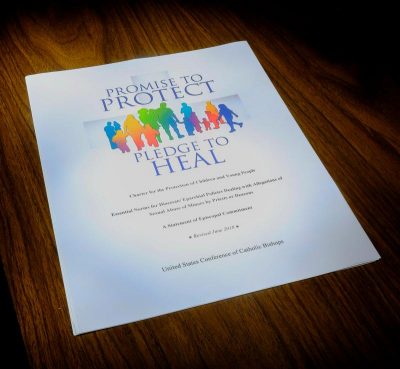
This is the cover of the USCCB “Charter for the Protection of Children and Young People.” (CNS photo illustration/Rick Musacchio, Tennessee Register)
WASHINGTON (CNS) — Surveys show that many Catholics are unaware of the steps that the bishops have taken since 2002 to prevent child abuse and to monitor its own performance.
In 2002, the U.S. bishops first approved their “Charter for the Protection of Children and Young People” to spell out protocols for how U.S. Catholic dioceses and eparchies must address sex abuse.
The charter, which is revised regularly, spells out strict procedures for removing from ministry those credibly accused of abusing minors.
It also called for training children and all adults who work with them in church and school settings to recognize and appropriately handle possible sexual abuse, and created diocesan and national mechanisms for monitoring compliance.
The charter established the position of victim assistance coordinator in every diocese and eparchy “to coordinate assistance for the immediate pastoral care of persons who report having been sexually abused as minors by clergy or other church personnel.”
[hotblock]
The charter directs action in:
— Creating a safe environment for children and young people.
— Healing and reconciliation of victims and survivors.
— Making prompt and effective response to allegations.
— Cooperating with civil authorities.
— Disciplining offenders.
The charter mandated the creation of the Office (now Secretariat) of Child and Youth Protection, which assists office assists “in the consistent application of principles” adopted by the charter and provides “a vehicle of accountability and assistance” to dioceses and eparchies.
In 2002, the bishops also established the lay-run National Review Board to monitor implementation of the charter. Francesco Cesareo has been the board’s chairman since 2013. He is president of Assumption College in Worcester, Massachusetts.
The full text of the U.S. bishops charter can be found in English and Spanish.
Under the charter, each diocese and eparchy undergo an annual audit to ensure compliance with it. Each audit report includes recommendations for corrective action where shortcomings are discovered.
Last June, the 15th annual report on implementation of the charter showed a decrease in allegations of clergy sex abuse from the two previous years but also indicated the need for continued vigilance since charges were raised by more than 650 adults and 24 minors.
The audit also showed that dioceses/eparchies provided outreach and support to 1,905 victims/survivors; training on abuse prevention and safe environment was provided to more than 4.1 million children and more than 56,000 priests, deacons and candidates for ordination; and background checks have been administered to 97 to 99 percent of all adults serving in ministry with children.
“That’s no small feat,” Cesareo told attendees at the Child and Youth Protection Catholic Leadership Conference in New Orleans last June. “Yet, we are not finished. We can never be finished.”
During the U.S. bishops’ general fall assembly in Baltimore in November, Cesareo called for broadening the scope of the “Charter for the Protection of Children and Young People” to include bishops. He also urged publishing complete lists of credibly accused clergy in all dioceses; improving the audit process; and enhancing accountability for bishops regarding cases of abuse.
PREVIOUS: Kurtz: ‘Gift of religious freedom’ at risk of ‘being taken for granted’
NEXT: Arkansas diocese updates clergy abuse report after independent review



Share this story